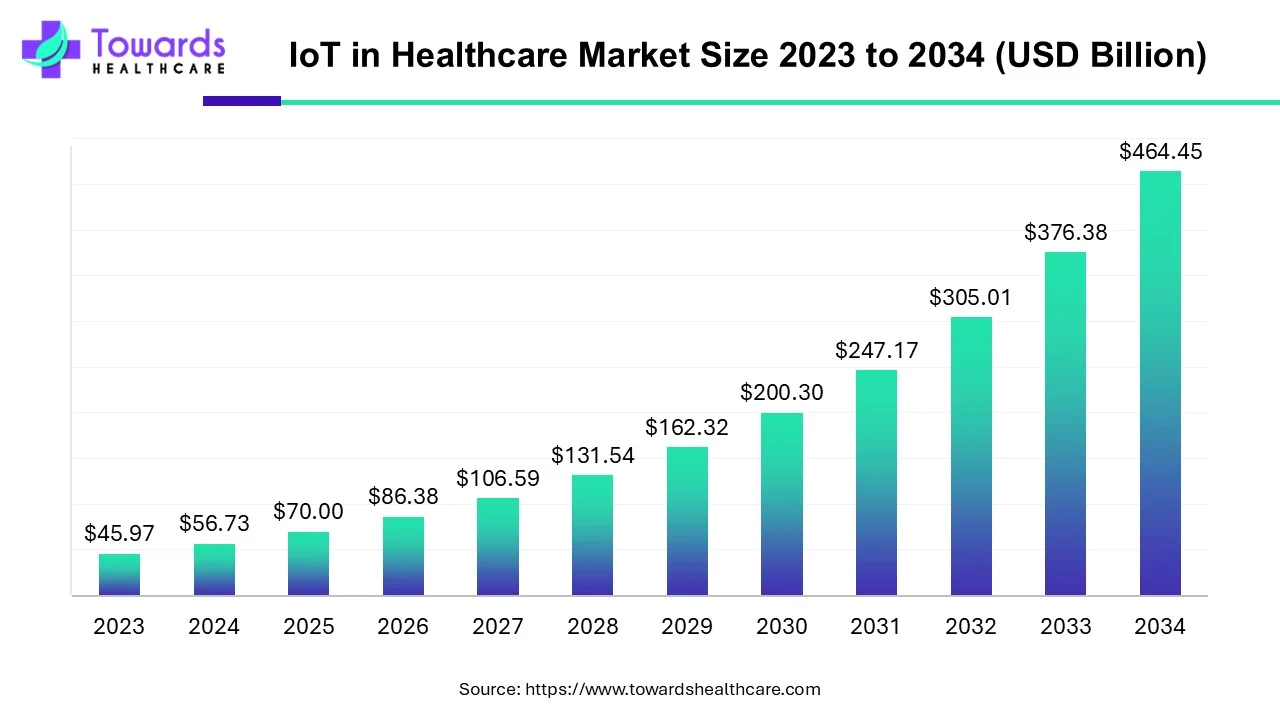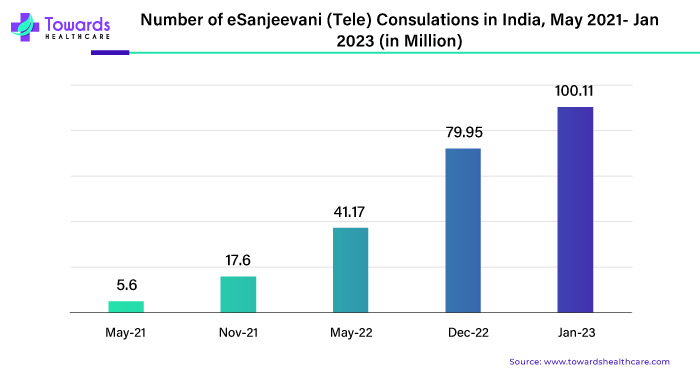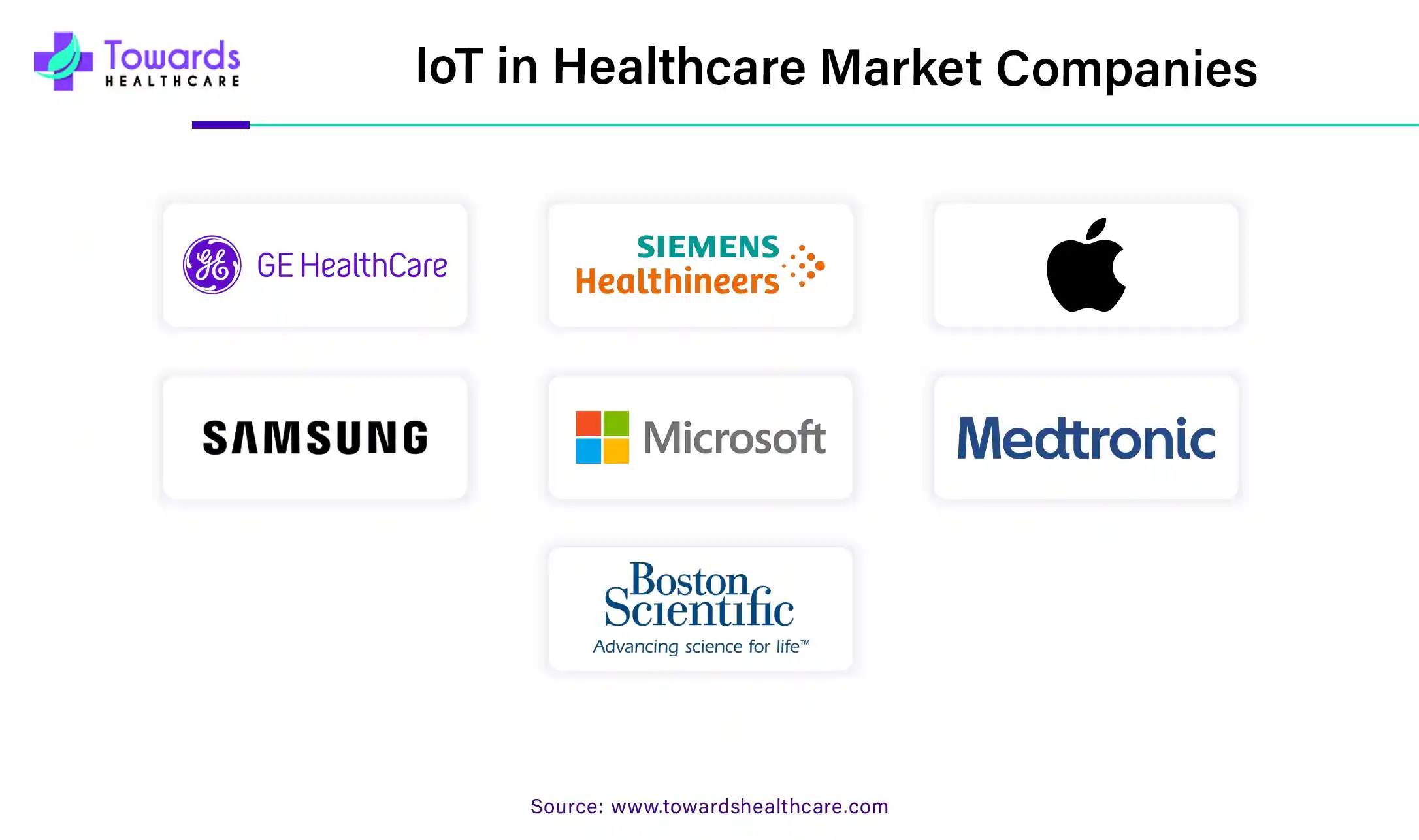November 2025

The IoT in healthcare market is forecast to grow at a CAGR of 23.4%, from USD 70 billion in 2025 to USD 464.45 billion by 2034, over the forecast period from 2025 to 2034. The growing need for enhanced patient care, technological advancements, and increasing investments are the major growth factors of the market.

In 2023, according to the American Hospital Association, about 74% of patients in the US used telehealth services through the IoT in healthcare, showing tremendous growth in the healthcare sector.
The IoT in healthcare is a transformative paradigm within the healthcare sector, harnessing the power of connectivity to revolutionise various aspects of medical practices. The essence of IoT in healthcare lies in creating a seamlessly interconnected ecosystem where medical devices, applications, and systems communicate, share data and collaborate in real time.
IoT in healthcare involves the integration of a wide array of medical devices, ranging from wearable fitness trackers to sophisticated diagnostic equipment. These devices communicate with each other through the Internet, forming a comprehensive network that allows for continuous monitoring and data exchange. One of the key objectives of the IoT in healthcare is to facilitate the efficient collection and sharing of healthcare data. Medical devices generate a wealth of information, including patient vitals, treatment responses and overall health trends. This data can be instantly transmitted to healthcare providers, enabling timely and informed decision-making. The IoT in healthcare allows remote monitoring of patients in real time.
Wearable devices, for instance, can track vital signs and transmit this information to healthcare professionals, allowing for proactive intervention and personalized care plans. This is particularly beneficial for patients with chronic conditions or remote locations. The interconnected nature of IoT in healthcare contributes to more precise diagnostics and treatment strategies. Healthcare providers can access a holistic view of a patient's health history, enabling them to tailor treatments based on individual profiles. Additionally, IoT in healthcare can facilitate the integration of artificial intelligence algorithms for more accurate diagnostics.
The global application of the IoT in healthcare is experiencing a remarkable increase, driven by an intersection of factors. Rapid technological advancements in sensors, connectivity, and data analytics foster the development of sophisticated IoT in healthcare solutions, providing healthcare with innovative tools for improved patient outcomes and operational efficiency. The demand for remote patient monitoring, amplified by ageing populations and the prevalence of chronic diseases, has accelerated IoT in healthcare adoption. The COVID-19 pandemic has further propelled the acceptance of IoT in healthcare with the rapid adoption of telehealth and remote monitoring solutions. Increased investments in digital health technologies, supportive regulatory frameworks, collaborative efforts, and the global trend toward personalized healthcare contribute to the widespread growth and application of IoT in healthcare globally. This surge signifies a transformative shift in healthcare, leveraging interconnected technologies to enhance medical practices and patient care worldwide.
Integrating artificial intelligence (AI) in IoT provides synergistic effects on the overall outcome of healthcare applications. AI increases the connectivity between medical devices. AI-enabled sensors improve the functioning of IoT-based devices by monitoring vital signs such as heart rate, blood pressure, and oxygen. AI and IoT can notify patients about their medications, ensuring adherence to treatment plans. They can analyze medical images, enhancing precision and accuracy. This enables healthcare professionals to make timely decisions. AI can help enhance patient experience and safety, reducing inefficiency in healthcare. Hence, the combination of AI and IoT enhances patient care and reshapes the medical landscape.
IoT in healthcare is revolutionizing patient care by integrating technology into everyday medical practices. This shift is crucial as the healthcare industry grapples with rising costs, an aging global population, and an increase in chronic diseases. IoT enhances operations and patient care through devices like X-ray machines, patient monitors, and hospital meters.
Key benefits of IoT in healthcare include:
Overall, IoT is making healthcare more accessible, better, and affordable, addressing the dual pressures of increased demand and underfunding in national healthcare systems worldwide.
The World Health Organization (WHO) suggests that only 14 of every 100 individuals globally receive the necessary healthcare. Each year, around 40 million people require palliative care, with approximately 78% of them residing in economically challenged nations. This underscores the significant gap in access to care, especially for those facing life-threatening illnesses, particularly in regions with limited resources. The growing need for remote patient monitoring, especially in the context of ageing populations and the prevalence of chronic diseases, fuels the demand for IoT in healthcare solutions. These technologies enable healthcare providers to monitor patients in real time, enhancing patient care and reducing the burden on healthcare facilities.
The increased demand for remote monitoring, a key driver in the growth of the IoT in healthcare market, is rooted in several critical factors. Firstly, the ageing population worldwide is leading to a higher incidence of chronic diseases and a greater need for continuous health monitoring. IoT in healthcare solutions, such as wearable devices and remote monitoring systems, address this demand by providing real-time data on patients' vital signs and health metrics. This capability is particularly beneficial for individuals with chronic conditions, allowing healthcare providers to detect early signs of deterioration or changes in health status.
Additionally, the prevalence of chronic diseases has put a strain on healthcare facilities, necessitating more efficient and proactive approaches to patient care. IoT in healthcare facilitates remote patient monitoring, enabling healthcare professionals to track patients' health parameters without frequent in-person visits. This enhances patient care by allowing for timely interventions and reducing the burden on healthcare facilities, optimizing resource allocation and overall operational efficiency.
| Sr. No. | Date EUA Issued | Device Type | Letter of Authorization |
| 1. | 14 May 2020 | Remote Patient QT Interval Monitor | G Medical Innovations, Ltd., VSMS Patch |
| 2. | 11 May 2020 | Nurse Call System | Ascom(US), Telecare |
| 3. | 26 April 2020 | Remote Patient Monitoring | PhysiolGaurd, ECG-QT Analysis System |
| 4. | 8 May 2020 | Patient Isolation Transport Unit | Patient Isolation Transport Device |
The IoT in healthcare market experiences growth in response to this increased demand as healthcare providers and institutions recognize the potential benefits of adopting remote monitoring solutions. The ability to monitor patients in real-time improves the quality of care and contributes to cost savings by preventing hospital readmissions and minimizing emergency interventions. As a result, there is a growing investment in IoT in healthcare technologies to meet the expanding requirements for remote patient monitoring. The convergence of these factors—ageing populations, rising chronic disease rates, the need for efficiency in healthcare delivery, and the proven benefits of IoT in healthcare solutions—contributes to the sustained and increasing growth of the IoT in healthcare market globally.
The IoT in healthcare market is experiencing growth due to advancements in technology. This expansion is evident in the increased adoption of innovative devices and solutions in healthcare. The swift evolution of IoT in healthcare contributes to improved capabilities, efficiency, and effectiveness in monitoring and managing various aspects of health. As a result, this technological progress fosters the growth of the IoT in healthcare market, providing healthcare professionals with enhanced tools for remote monitoring, diagnostics and personalized care. The continuous advancements in IoT in healthcare meet the evolving needs of the healthcare sector and contribute to the overall expansion and impact of this transformative technology on the industry.
In correlation with these trends, the IoT in healthcare market is witnessing an increase. The surge in telemedicine adoption contributes significantly to the growth of IoT in healthcare technologies, showcasing a growing reliance on interconnected medical devices for remote healthcare services. The preference for teleconsultations, driven by convenience and satisfaction, underscores the expanding role of IoT in healthcare in reshaping the healthcare landscape on a global scale.
The expansion of the IoT in healthcare market faces obstacles primarily rooted in privacy and security apprehensions. IoT in healthcare devices, which generate and transmit substantial volumes of sensitive health data, evoke concerns regarding unauthorized access and the possibility of data breaches. This heightened vulnerability prompts patients and healthcare providers to be cautious about the confidentiality of personal health information.
Additionally, The fear of potential breaches and misuse of health data contributes to a reluctance among stakeholders to adopt IoT in healthcare solutions. This hesitation stems from the paramount importance of safeguarding sensitive medical information, which, if compromised, could lead to severe consequences for individuals' privacy and healthcare institutions' integrity. To mitigate these concerns and promote the widespread adoption of IoT in healthcare technologies, it is imperative to implement and continuously enhance robust privacy and security measures. This involves employing encryption protocols, secure data transmission mechanisms and stringent access controls. Additionally, compliance with regulatory standards and frameworks such as HIPAA (Health Insurance Portability and Accountability Act) is crucial in establishing trust within the healthcare ecosystem.
By addressing these privacy and security challenges effectively, the IoT in healthcare market can instil confidence among users, paving the way for broader acceptance and unlocking the full potential of these transformative technologies in improving healthcare delivery and patient outcomes.
The increasing demand for telehealth drives the IoT in healthcare market. As telehealth gains prominence, IoT in healthcare is pivotal in facilitating remote patient monitoring, telemedicine consultation, and efficient data exchange between healthcare providers and patients. This surge in demand is fueled by the need for accessible and convenient healthcare solutions, leading to integrating IoT in healthcare devices and technologies to enhance patient care, streamline processes, and ultimately contribute to the growth of the healthcare industry.
Some notable highlights:

Telehealth, as a component of the broader IoT in healthcare, has been experiencing significant growth. Even before the COVID-19 pandemic, telehealth was gaining traction, and the global health crisis further accelerated its adoption.
Benefits of Telehealth
By component, the medical devices segment held a dominant presence in the market in 2024. The rapidly evolving medical device sector leads to the integration of IoT, yielding faster and more efficient results. IoT-enabled medical devices automate the detection of heart rate, blood pressure, temperature, and other patient vital signs. This helps healthcare professionals continuously monitor a patient’s condition. IoT in medical devices can also enhance the diagnostic accuracy of an instrument, leading to effective and timely clinical decision-making. IoT devices can also enable minimally invasive surgeries, resulting in faster recovery and reduced manual errors.
By component, the system & software segment is expected to grow at the fastest rate in the market during the forecast period. IoT systems and software increase connectivity and networking through platforms, embedded systems, partner systems, and middleware. The advent of cloud computing promotes the segment’s growth. This enables healthcare professionals to access patient data from anywhere and at any time. Systems and software also eliminate the need for specialized infrastructure in a healthcare setting.
By connectivity technology, the cellular segment held the largest share of the market in 2024. Advancements in cellular network technology, such as 4G, 5G, and 6G, augment the segment’s growth. This technology allows remote patient monitoring, data collection, and improved data access. Cellular technology is widely preferred as it is reliable, scalable, secure, and provides better data access. This technology helps to maintain privacy and reduces the risk of data leakage.
By connectivity technology, the LPWANs segment is anticipated to grow with the highest CAGR in the market during the studied years. Low Power Wide Area Networks (LPWANs) can collect and transmit healthcare data over distance networks autonomously. LPWAN-based IoT allows the monitoring of patient vital signs, and the received data can be used to implement various healthcare services. It is widely preferred as it is highly efficient and cost-effective.
By application, the telemedicine segment led the global market in 2024 and is projected to expand rapidly in the market in the coming years. Telemedicine enables patients to receive medical consultations from remote areas. This eliminates the need to physically visit any healthcare setting, saving a lot of time for patients and healthcare providers. The increasing geriatric population increases the demand for telemedicine. This leads to improved access to healthcare and cost-effective treatment, increasing the accessibility of advanced treatment.
By end-use, the hospitals & clinics segment held the major share of the market in 2024. The segmental growth is attributed to suitable capital investment, favorable infrastructure, and the increasing number of hospitalizations. IoT helps healthcare professionals to provide personalized care and manage huge amounts of patient data in hospitals and clinics. Hospitals and clinics possess specialized equipment for diagnosing and treating different disorders.
By end-use, the clinical research organizations segment is predicted to witness significant growth in the market during the forecast period. Clinical research organizations (CROs) conduct research for many academic institutes and industries as they provide state-of-the-art services. The presence of skilled professionals and technologically advanced equipment increases the demand for CROs. IoT helps in faster and more effective drug development, reduces development costs, and streamlines the supply chain. This helps several pharma & biotech companies to focus on marketing and strengthen their market position.
The IoT in healthcare market in North America presents a dynamic and robust landscape, with the region at the forefront of advanced healthcare technology adoption. The United States and Canada are pivotal in shaping this market, with the U.S. serving as a significant driver of IoT in healthcare innovation. Factors influencing the U.S. IoT in healthcare market include leading technology companies, extensive healthcare R&D activities, and a strong focus on digital health solutions. Collaborations between technology firms, healthcare providers, and regulatory bodies contribute significantly to the growth of IoT in healthcare applications.
Meanwhile, Canada demonstrates a growing interest in IoT in healthcare, leveraging its advanced healthcare system to integrate intelligent medical devices. Government initiatives and partnerships between healthcare organizations and technology companies fuel IoT in healthcare developments in Canada, emphasizing enhancements in patient care, optimized healthcare workflows, and addressing challenges through technological advancements.
The European IoT in healthcare market showcases a diverse and rapidly evolving landscape. Major economies, including Germany, the United Kingdom and France, are at the forefront of IoT in healthcare adoption, leveraging advanced healthcare technologies. These countries boast robust infrastructure and healthcare systems, fostering a conducive environment for IoT in healthcare integration. Eastern European nations, such as Poland and Hungary, are also witnessing growing interest in IoT in healthcare solutions, driven by increasing healthcare investments and a focus on technological advancements. The Southern European region, including Spain and Italy, is gradually embracing IoT in healthcare, with healthcare providers exploring ways to enhance patient care through innovative technologies.
The German government actively supports the adoption of digitization in healthcare organizations through two main initiatives, such as “The Digital Act” and “Health Data Use Act”. The main aim of the former initiative is to set up an electronic patient record for all persons with statutory insurance, while the latter focuses on progressing and improving the use of data for research and innovation in healthcare.
The French government announced an investment of €650 million to become a leader in digital health by bringing digital transformation to the healthcare sector. The initiative “France 2030” boosts the adoption of emerging technologies, owing to 92.6% internet penetration.
The Asia Pacific IoT in healthcare market is undergoing dynamic growth, marked by heightened healthcare technology adoption. Key contributors to this transformative evolution include influential countries such as China, where substantial investments in healthcare technology have positioned it as a central influencer. China's focus on digital health initiatives and technological innovation, coupled with its vast population, creates a fertile ground for developing IoT in healthcare solutions.
The Indian healthcare sector is undergoing digital transformation, owing to government initiatives and technological advancements. The need for telemedicine has increased since the launch of eSanjeevani, the government’s telemedicine app, and the COVID-19 pandemic. The free-to-use National Telemedicine Service provided over 276 million consultations, enhancing accessibility to medical care.
It is estimated that 14 million Koreans were provided with telemedicine care from February 2020 to January 2023. The South Korean Ministry of Health and Welfare is committed to launching a nationwide pilot to offer telemedicine services. The three-month pilot project allows providers to use video conferencing or voice calls for remote care.
Kirsten Newquist, CEO of Identiv, commented that collaborating with InPlay enables the company to drive Bluetooth Low Energy (BLE) technology as the next-gen standard for IoT applications. He added that the company is excited to develop solutions that meet the demands of cold-chain monitoring for food safety, logistics, and healthcare industries.

By Component
By Connectivity Technology
By Application
By End-use
By Region
November 2025
November 2025
November 2025
November 2025